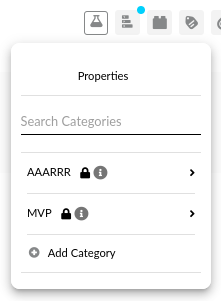- /
- /
- /
Add Properties
Add structure and clarity to your cards with properties. Properties help you organise cards. Not only can you see which cards share similar characteristics at a glace, but you can also filter cards by properties to show only those cards that match.
Properties are arranged in categories. Categories are groups of related properties, for example, you might create a custom category called “Channels”, which contains properties for “Content Marketing”, “PR” and “Sales”. There are two types of properties:
- Custom properties: These are properties that you create and administer yourself. Before you add custom properties you must first create a custom category in which all your properties will sit.
- System-defined properties: These represent established growth experimentation methodologies and cannot be edited or deleted. You can distinguish a system-defined property from a custom property by the padlock and information icon by it’s name.
In the following tables, we define the system-defined properties available in Wowzers.
AAARRRR.
AAARRRR, also known as the Pirate Funnel, outlines the seven critical steps in a typical customer journey from Awareness to Reactivation. It helps you to understand your customers and optimise your funnel.
| Property | Description |
| Awareness | Awareness is all about getting your name out there. It is a brand-building exercise designed to introduce people to your business, products and services while motivating them to take action. |
| Acquisition | Acquisition transforms anonymous visitors into prospects (potential customers). It represents the first transaction you have with a prospect, usually in the form of a sign-up or request for information. |
| Activation | Activation is about getting prospects and users hooked so they use your offering, or make repeat purchases. The more they use your product or service, the greater the odds they will stick around. |
| Retention | Retention is about getting prospects and users hooked so they use your offering, or make repeat purchases. The more they use your product or service, the greater the odds they will stick around. |
| Referral | Referral marketing is when you actively encourage customers to recommend your offering to friends and family, thereby increasing your reach and credibly bolstering your brand. |
| Revenue | Revenue is where prospects become customers and make a transaction. For SaaS companies, this could be a monthly subscription, for service firms, the receipt of a signed contract or security fee. |
| Reactivation | Reactivation is the process of re-engaging churned customers (those who have stopped using your offering) and encouraging them to pick up where they left off, usually with the aid of an incentive. |
MVP’s.
MVP stands for Minimum Viable Product. It is the“…version of a new product which allows a team to collect the maximum amount of validated learning about customers with the least effort”. (Eric Ries, Author of The Lean Startup).
| Property | Description |
| Concierge | A Concierge MVP gives individual customers the ‘white-glove’ treatment, using manpower front and centre to deliver your product or service in the absence of automation or complex systems. |
| Explainer Video | An Explainer Video MVP walks potential customers through what your product is and how it can help them through a video, without having to invest in any supporting infrastructure or development. |
| Landing Page | A Landing Page MVP explains your offering, it’s features and benefits, and encourages customers to sign-up, helping gauge customer interest in your offering before investing resources (time, money, effort). |
| Piecemeal | A piecemeal MVP is the use of existing third-party products or services to assemble your offering, usually through the use of application program interface (API) to connect the component parts. |
| Raise Funds | A Raise Funds MVP asks prospective customers to put their money on the table, helping you gauge market appetite for your new product or service by how much $$$ are raised while building pre-orders. |
| Single Feature | A Single feature MVP is the act of building a product or solution to solve a specific problem or need. MVE’s are usually one-trick ponies; offerings with a single feature or purpose, for example, a plugin. |
| Wizard of Oz | A Wizard of Oz MVP involves building a façade which looks and behaves like an automated product but is a skeleton operation whereby all aspects of the customer experience are orchestrated manually. |
| Not an MVP | Not an MVP, as the name suggests, is a pre-existing offering that does not need to be taken to market, or the launch of a fully-fledged product or service that hasn’t yet achieved product-market fit. |
How to add properties.
To add a property, follow these steps:
- Click the ‘Select Properties’ icon in the card header.
- Locate the property you wish to add in the properties panel.
- Click on the property name.
The property will appear on the card. You can now close the ‘Add Properties’ panel.
How to create custom properties.
To add a property, follow these steps:
- Click the ‘Select Properties’ icon in the
- Click ‘Add Category’.
- Enter a category name and click ‘Create Category’.
Now that you’ve created a category, proceed to add custom properties to this category by following these steps.
- Click on the custom category name you’ve just created.
- Click ‘Add Property’.
- Enter a property name and click ‘Create Property’
The property will appear under the category you created.
How to remove properties.
To remove a property, follow these steps:
- Click the ‘Select Properties’ icon in the card header.
- Locate the property you wish to remove in the properties panel.
- Click the property name.
The properties will be removed from the card. You can now close the ‘Add Properties’ panel.

